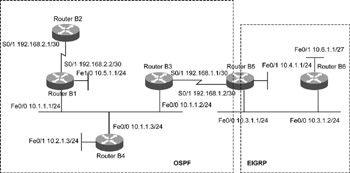Case Study
Consider the network shown in Figure 9.8. The OSPF network consists of routers B1, B2, B3, B4, and B5. EIGRP is running among routers B5 and B6. Redistribution between OSPF and EIGRP is configured in router B5, which is running both routing protocols.

Figure 9.8: A network configured with OSPF and EIGRP routing protocols.
In Figure 9.8, the OSPF network faces some problems. They are:
-
B2 is not visible as a neighbor of B1.
-
Route 10.6.1.1/27 is not available in the routing table of B4.
B2 Is Not Visible as a Neighbor of B1
B1 and B2 are connected via a serial link. B2 is not visible as a neighbor of B1. To troubleshoot this problem:
-
Check the status of the serial link by using the show interface Serial 0/1 command. The output of the show interface Serial 0/1 command is shown in Listing 9.23.
Listing 9.23 Output of show interface Serial 0/1 Command
B1#show interface Serial 0/1 Serial0/1 is up, line protocol is up Hardware is HD64570 Description: WAN link to router B2 Internet address is 192.168.2.2/30 MTU 1500 bytes, BW 1544 Kbit, DLY 20000 usec, reliability 255/255, txload 1/255, rxload 1/255 Encapsulation HDLC, loopback not set Keepalive set (10 sec) Last input 00:00:00, output 00:00:00, output hang never Last clearing of "show interface" counters never Input queue: 0/75/3134350/0 (size/max/drops/flushes); Total output drops: 11 Queueing strategy: weighted fair Output queue: 0/1000/64/0 (size/max total/threshold/drops) Conversations 0/11/256 (active/max active/max total) Reserved Conversations 0/0 (allocated/max allocated) 5 minute input rate 13000 bits/sec, 29 packets/sec 5 minute output rate 2000 bits/sec, 3 packets/sec 115001192 packets input, 4155732628 bytes, 272 no buffer Received 425130 broadcasts, 0 runts, 0 giants, 0 throttles 228 input errors, 227 CRC, 68 frame, 0 overrun, 0 ignored, 34 abort 21650119 packets output, 3170761599 bytes, 0 underruns 0 output errors, 0 collisions, 1 interface resets 0 output buffer failures, 0 output buffers swapped out 10 carrier transitions DCD=up DSR=up DTR=up RTS=up CTS=up
Listing 9.23 shows that the interface is physically up.
-
Check the basic IP level connectivity using the B1#ping 192.168.2.1 command. The command output shows a 100% success rate to confirm that Layer 3 connectivity is working between B1 and B2. It is confirmed that there are no problems or errors in the physical link.
-
Check if OSPF is defined for the interfaces Serial0/1 in B1 and B2 by using the show ip ospf interface Serial0/1 command. The output of the show ip ospf interface Serial0/1 command at B1 is shown in Listing 9.24.
Listing 9.24 Output of the show ip ospf interface Serial0/1 Command at B1
B1#show ip ospf interface Serial0/1 Serial0/1 is up, line protocol is up Internet Address 192.168.2.2/30, Area 5 Process ID 1, Router ID 192.168.2.2, Network Type POINT TO POINT, Cost: 64 Transmit Delay is 1 sec, State POINT TO POINT, Timer intervals configured, Hello 10, Dead 40, Wait 40, Retransmit 5 No Hellos (Passive interface) Index 7/7, flood queue length 0 Next 0x0(0)/0x0(0) Last flood scan length is 0, maximum is 0 Last flood scan time is 0 msec, maximum is 0 msec Neighbor Count is 0, Adjacent neighbor count is 0 Suppress hello for 0 neighbor(s) Simple password authentication enabled
Listing 9.24 shows that the interface Serial0/1 in B1 has been defined as a passive interface that is preventing the formation of neighbor relationship. The output of the show ip ospf interface Serial0/1 command at B2 is shown in Listing 9.25.
Listing 9.25 Output of the show ip ospf interface Serial0/1 Command at B2
B2#show ip ospf interface Serial0/1 Serial0/1 is up, line protocol is up Internet Address 192.168.2.1/30, Area 5 Process ID 1, Router ID 192.168.2.1, Network Type POINT TO POINT, Cost: 64 Transmit Delay is 1 sec, State POINT TO POINT, Timer intervals configured, Hello 10, Dead 40, Wait 40, Retransmit 5 Hello due in 00:00:02 Index 7/7, flood queue length 0 Next 0x0(0)/0x0(0) Last flood scan length is 0, maximum is 0 Last flood scan time is 0 msec, maximum is 0 msec Neighbor Count is 0, Adjacent neighbor count is 0 Suppress hello for 0 neighbor(s) Simple password authentication enabled
Listings 9.24 and 9.25 show that OSPF is running at both the neighboring interfaces of B1 and B2. The commands to restore normalcy and establish neighbor relationship between B1 and B2 are:
B1(config)#router ospf 1 B1(config-router)#no passive-interface Serial 0/1
Route 10.6.1.1/27 Is Unavailable in Routing Table of B4
Route unavailability is caused by problems in redistribution configuration. To troubleshoot this problem:
-
Check if route 10.6.1.1/27 is available at B5 by using the #show ip route | include 10.6.1.1 command. The output is:
#show ip route | include 10.6.1.1 D 10.6.1.1/27 [90/1100] via 10.3.1.2, 00:00:33,
The command output shows that the EIGRP route is present at the routing table of B5.
-
Check if the keyword subnets is used, in case of redistribution into OSPF. The configuration in B5 should be:
router ospf 1 redistribute eigrp metric 10 subnets
The keyword subnets is mandatory so that the subnets to a major network are redistributed properly into OSPF and are visible in the routing table.
EAN: 2147483647
Pages: 130